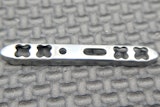High energy efficiency goals demand flexible automation systems for a variety of buildings over several areas.
Global challenges in energy generation and consumption motivates governments worldwide to set ambitious goals for increased energy efficiency, which results in a fast growing need for energy-efficient buildings. Therefore, innovative, sustainable technologies that can be easily installed, especially in retrofit projects, are a necessity if the governments’ ambitious objectives are to be realized.
Buildings consume more than 40 percent of primary energy. Over a trillion dollars in energy savings opportunities are available in the U.S., but in order to realize these savings, state and local programs need to become involved by financing efficiency measures – offering programs such as repayment on utility bills or property tax bills. Such measures, including the support of efficient technologies to increase energy productivity across the economy, are part of the Energy 2030 plan of the Alliance Commission on National Energy Efficiency Policy, with U.S. government objectives to cut energy waste in buildings and homes in half.
Sustainable Advantage
Energy harvesting wireless technology becomes more attractive for OEMs as a basis technology for products and solutions that contribute to a building’s efficient energy management. The wireless modules gain their power from the surrounding environment. In the process, an electrodynamic energy converter uses mechanical motion or a miniaturized solar module generating energy from light. Combining a peltier element with a DC/DC ultra-low-voltage converter taps heat as an energy source. Even the smallest amounts of harvested energy are sufficient to transmit a wireless signal. The addition of a capacitor can ensure adequate power storage to bridge intervals when no energy can be harvested.
Energy harvesting technology enables batteryless automation devices and systems to make buildings more energy-efficient based on sustainable, resource-saving technologies that eliminate the need for batteries. This makes the difference for OEMs when deciding on wireless technologies, as at the end of their lifetime, batteries are, and remain, hazardous waste and need to be carefully (and expensively) disposed. In addition, batteries contradict the sustainability and “green” aspect that intelligent control systems offer buildings when making them more energy efficient.
No Compromise in Performance
Energy harvesting wireless devices are low energy, but not low power. For optimal RF effectiveness, the radio protocol uses 315 MHz and 902 MHz frequency bands in the US. The sub1 GHZ radio waves have twice the range of 2.4 GHz signals for the same energy budget, and better penetration within buildings. As a reference point, duplicating the energy harvesting wireless system at 2.4 GHz system requires about four times more receiver nodes to cover the same area. RF reliability is assured because wireless signals are just 0.7 milliseconds in duration and are transmitted multiple times for redundancy. The range of energy harvesting wireless sensors is about 900 ft in an open field and up to 90 ft inside buildings.
In comparison to 315 MHz, the 902 MHz modules allow for integration into very small product enclosures due to short antenna length. Interference from co-located devices such as light ballasts and LED drivers are at a minimum. These enable an effective, robust wireless platform for applications in the building automation sector, smart home solutions, consumer appliances, or machine-to-machine communication.
The Link to Networks
The interconnection of a system’s sensors and relay receivers with a central control to an adaptive network must be intelligent. Therefore, there is an increasing demand to incorporate batteryless, wireless devices into networks based on several different communication standards such as WiFi, GSM, Ethernet/IP, BACnet, LON, KNX, DALI, etc. Previously, OEMs had to develop individual software solutions, transferring energy harvesting wireless signals into the requested communication protocol. This challenge is now overcome by EnOcean Link, the first middleware for energy harvesting wireless networks.
EnOcean Link converts the bits and bytes of an EnOcean telegram directly into data values. In doing so, the middleware automatically takes into account the specifications of the EnOcean protocol stack and the EnOcean Equipment Profiles (EEPs) of the EnOcean Alliance, as well as encryption mechanisms. All wireless applications can have a ready-made key to the wireless energy harvesting world. Since the software interprets all data, it also ensures the interoperability of equipment from different manufacturers.
Meeting Individual Building Needs
In a complex commercial building scenario, EnOcean Link can be implemented on a central device, like a control server, which controls the whole building, holds the automation intelligence, and can be physically located outside the building (in the cloud). Several gateways in the building record radio telegrams from thousands of distributed batteryless wireless sensors and relay receivers, and send back information or command data when needed. These gateways are connected to the control server by a backbone, which does not have to be based on EnOcean radio, or even be wireless. The middleware, located in the central unit, interprets all telegrams received by the gateways and provides them to the automation system.
High energy efficiency goals demand flexible automation systems for all kind of buildings that cover several areas. This particularly affects retrofit projects, where the intelligent control of energy consumption is the key factor for a building’s improved energy and carbon footprint. Energy harvesting wireless technology fulfills the demands for today’s and tomorrow’s automation and energy management systems. The devices provide the advantages of wireless communication, including a more flexible planning and implementation, combined with a comfortable user experience. In addition, the energy harvesting principle is a unique aspect that ensures the sustainability of all system components, bringing the cleantech idea to each single sensor.























